Related Research Articles

New York City Hall is the seat of New York City government, located at the center of City Hall Park in the Civic Center area of Lower Manhattan, between Broadway, Park Row, and Chambers Street. Constructed from 1803 to 1812, the building is the oldest city hall in the United States that still houses its original governmental functions. The building houses the office of the Mayor of New York City and the chambers of the New York City Council. While the Mayor's Office is in the building, the staff of thirteen municipal agencies under mayoral control are located in the nearby Manhattan Municipal Building, one of the largest government buildings in the world, with many others housed in various buildings in the immediate vicinity.

Thomas Ustick Walter was an American architect of German descent, the dean of American architecture between the 1820 death of Benjamin Latrobe and the emergence of H.H. Richardson in the 1870s. He was the fourth Architect of the Capitol and responsible for adding the north (Senate) and south (House) wings and the central dome that is predominantly the current appearance of the U.S. Capitol building. Walter was one of the founders and second president of the American Institute of Architects. In 1839, he was elected as a member to the American Philosophical Society.

Richard Upjohn was a British-born American architect who emigrated to the United States and became most famous for his Gothic Revival churches. He was partially responsible for launching the movement to popularity in the United States. Upjohn also did extensive work in and helped to popularize the Italianate style. He was a founder and the first president of the American Institute of Architects. His son, Richard Michell Upjohn, (1828-1903), was also a well-known architect and served as a partner in his continued architectural firm in New York.

Downtown Brooklyn is the third largest central business district in New York City, and is located in the northwestern section of the borough of Brooklyn. The neighborhood is known for its office and residential buildings, such as the Williamsburgh Savings Bank Tower and the MetroTech Center office complex.
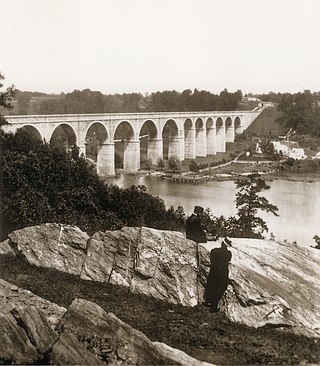
The Croton Aqueduct or Old Croton Aqueduct was a large and complex water distribution system constructed for New York City between 1837 and 1842. The great aqueducts, which were among the first in the United States, carried water by gravity 41 miles (66 km) from the Croton River in Westchester County to reservoirs in Manhattan. It was built because local water resources had become polluted and inadequate for the growing population of the city. Although the aqueduct was largely superseded by the New Croton Aqueduct, which was built in 1890, the Old Croton Aqueduct remained in service until 1955.
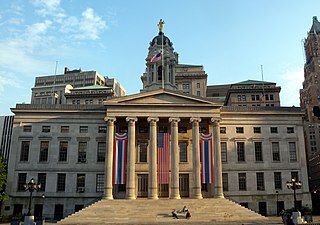
Brooklyn Borough Hall is a building in Downtown Brooklyn, New York City. It was designed by architects Calvin Pollard and Gamaliel King in the Greek Revival style, and constructed of Tuckahoe marble under the supervision of superintendent Stephen Haynes.

Samuel Sloan was a Philadelphia-based architect and best-selling author of architecture books in the mid-19th century. He specialized in Italianate villas and country houses, churches, and institutional buildings. His most famous building—the octagonal mansion "Longwood" in Natchez, Mississippi—is unfinished; construction was abandoned during the American Civil War.

Russell Warren (1783–1860) was an American architect, best known for his work in the Greek Revival style. He practiced in Bristol and Providence.
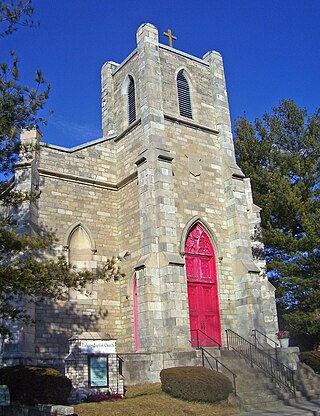
Calvary Baptist Church, originally St. Paul's Episcopal Church, is located on St. Paul's Place in Ossining, New York, United States. It is a stone building in the Gothic Revival architectural style, considered the best preserved early example of that style in Westchester County. It is also one of the few remaining Calvin Pollard buildings in the state. Built in the 1830s, it is the oldest house of worship in the village. In 1978 it and its rectory across the street were added to the National Register of Historic Places.

Gamaliel King was an American architect who practiced in New York City and the adjacent city of Brooklyn, where he was a major figure in Brooklyn civic and ecclesiastical architecture for several decades.

Frederick Clarke Withers was an English architect in America, especially renowned for his Gothic Revival ecclesiastical designs. For portions of his professional career, he partnered with fellow immigrant Calvert Vaux; both worked in the office of Andrew Jackson Downing in Newburgh, New York, where they began their careers following Downing's accidental death. Withers greatly participated in the introduction of the High Victorian Gothic style to the United States.
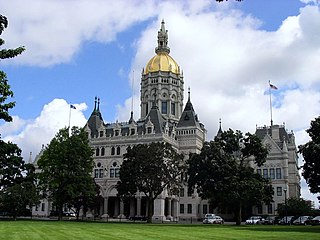
Richard Michell Upjohn, FAIA, was an American architect, co-founder and president of the American Institute of Architects.

City Hall Historic District is a national historic district located at Rochester in Monroe County, New York. The district consists of four buildings arranged in a 19th-century civic complex. The buildings are the Rochester City Hall (1874–1875), Monroe County Courthouse (1894–1896), Rochester Free Academy (1872–1873), and St. Luke's Episcopal Church (1824). Andrew Jackson Warner designed the City Hall and Free Academy buildings. His son, J. Foster Warner, designed the Monroe County Courthouse.

St. James Church is a historic Episcopal church building at 86-02 Broadway in the Elmhurst neighborhood of Queens in New York City. It is the city's oldest surviving Anglican building and Church of England mission church. It is also alternatively called the Old St. James Church to distinguish it from the St. James Episcopal Church two blocks away.
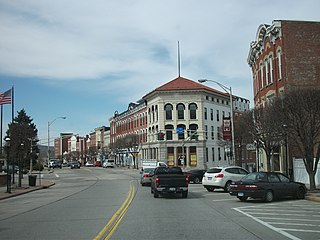
The Downtown Ossining Historic District is located at the central crossroads of Ossining, New York, United States, and the village's traditional business district known as the Crescent. Among its many late 19th- and early 20th-century commercial buildings are many of the village's major landmarks—three bank buildings, four churches, its village hall, former post office and high school. It was recognized as a historic district in 1989 and listed on the National Register of Historic Places, as one of the few downtowns in Westchester County with its social and historical development intact.

Benjamin S. Deane (1790–1867) was an American master builder and architect in practice in Bangor, Maine, from c. 1832 to 1867.
This is a timeline and chronology of the history of Brooklyn, New York. Brooklyn is the most populous of New York City's boroughs, and was settled in 1646.

Petersburg Courthouse is a historic courthouse building located at Petersburg, Virginia. It was designed by New York architect Calvin Pollard and built between 1838 and 1840. It is a two-story, Classical Revival style brick building. It rests on a granite foundation and measures 57 feet wide and 93 feet deep. It features a pedimented hexastyle front portico and a double-tiered bell and clock tower modeled after the Choragic Monument of Lysicrates in Athens. Major work was performed on the structure until 1877 when extensive repairs and interior alterations were carried out. A 30-foot addition was constructed in 1965. During the Siege of Petersburg, Union troops used the tower for a sighting mark and spared the structure from the bombardment.
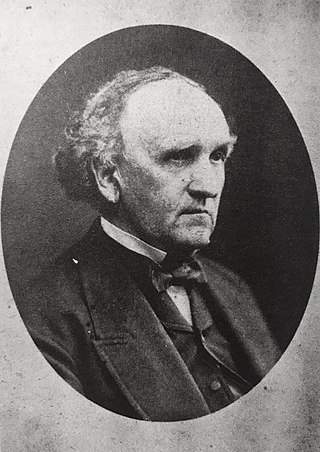
Thornton MacNess Niven (1806—1895) was a Scottish American architect and master stonecutter who worked primarily in Newburgh, New York, but also in several locations along the Hudson River and Southern United States. Although Niven considered himself more of a stonecutter than an architect, he acquainted himself with several men working to establish Gothic Revival and Italianate styles within American architectural practice—Andrew Jackson Downing, Alexander Jackson Davis, James H. Dakin, Russell Warren, and Calvin Pollard. In his early career as a granite stonecutter, Niven gained national acclaim.
References
Notes
- ↑ Weiskotten, Daniel H. "The Pollard Family of New Woodstock From New Woodstock and Vicinity, Past and Present, 1901". August 10, 2002. Rootsweb. Retrieved 19 December 2010.
- ↑ Markham, Sandra. "Guide to the Calvin Pollard Architectural Drawing Collection 1834-1852, undated". 2003. New York Historical Society. Retrieved 19 December 2010.
- ↑ Austin N. O'Brien (October 1978). "National Register of Historic Places Registration:St. Paul's Episcopal Church". New York State Office of Parks, Recreation and Historic Preservation. Archived from the original on 2012-10-18. Retrieved 2010-12-24.
- ↑ "Brooklyn Borough Hall". Department of Citywide Administrative Services, New York City. Archived from the original on 6 June 2012. Retrieved 19 December 2010.
- 1 2 "National Register Information System". National Register of Historic Places . National Park Service. March 13, 2009.
- ↑ "Petersburg Courthouse". Virginia.org. Archived from the original on 6 January 2011. Retrieved 19 December 2010.
- ↑ The Olympic Theatre (1837-1852) - Internet Broadway Database